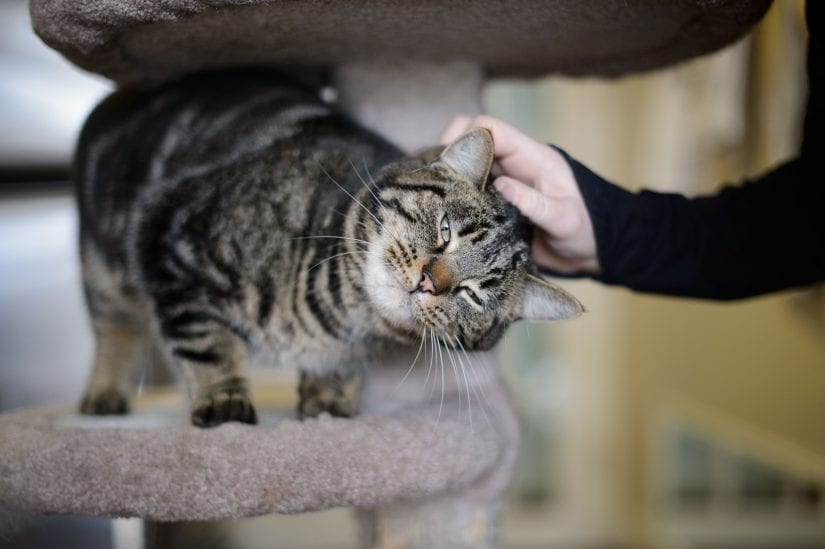"Discover the joy of adopting a shelter cat! Give a loving home to a cat in need, save money on expenses, and enjoy the companionship and happiness they bring"
Key Takeaways:
- Patience and understanding are key when bringing home a shelter cat, as they may need time to adjust to their new environment.
- Providing a safe and comfortable space for the cat to retreat to is essential in helping them feel secure.
- Gradually introducing the cat to other pets in the household can help prevent conflicts and promote positive relationships.
- Regular veterinary check-ups and vaccinations are crucial for the health and well-being of your shelter cat.
- Offering plenty of mental and physical stimulation through playtime, toys, and scratching posts can help prevent behavioral issues in shelter cats.
Why Should You Consider Adopting a Shelter Cat?
Adopting a shelter cat is a wonderful choice for many reasons. First, when you adopt from a shelter, you are giving a loving home to a cat in need. Many shelter cats have had difficult experiences and are looking for someone to provide them with care and affection. By adopting, you are making a big difference in their lives.
Secondly, adopting from a shelter is often more affordable than buying from a breeder or pet store. Shelters usually charge an adoption fee that includes vaccinations, spaying or neutering, and sometimes even microchipping. This can save you money on initial veterinary expenses.
Lastly, adopting a shelter cat can bring so much joy and companionship into your life. Cats make great pets—they are independent yet affectionate, and they can provide comfort and entertainment. Whether you live alone or have a family, having a cat as part of your household can bring happiness to everyone.
The Benefits of Adopting from Shelters:
- You give a loving home to an animal in need
- Adoption fees are usually more affordable
- Cats can bring joy and companionship into your life
A Personal Story:
I remember the day I adopted my shelter cat, Whiskers. He had been abandoned by his previous owners and was scared when I first met him at the shelter. But once I brought him home and gave him lots of love and attention, he quickly became comfortable in his new surroundings.
Whiskers has brought so much happiness into my life. He greets me at the door when I come home from work, curls up next to me on the couch while I watch TV, and even plays fetch with his favorite toy. I can't imagine my life without him.
If you're thinking about getting a cat, I highly recommend considering adoption. You'll not only be giving a deserving cat a second chance at a happy life, but you'll also gain a loyal and loving companion.
Important Steps to Take Before Bringing a Shelter Cat Home
Before bringing a shelter cat home, it is important to prepare your living space and make it safe and comfortable for your new feline friend. Start by designating a specific area in your home where the cat can initially stay, such as a spare room or bathroom. This will help the cat feel secure and gradually adjust to its new surroundings.
Gathering Supplies
Prior to bringing your shelter cat home, gather all the necessary supplies. This includes food and water bowls, litter box and litter, scratching posts or pads, toys, bedding, and a carrier for transportation. Having these items ready will ensure that your new cat has everything it needs from day one.
Preparing Your Home
Make sure your home is safe for your new cat by removing any potential hazards. Secure loose wires or cords that could be chewed on, store toxic plants out of reach, and close off any areas where the cat could get stuck or injured. Additionally, provide plenty of hiding spots and vertical spaces like shelves or cat trees for the cat to explore and feel safe.
Helping Your New Shelter Cat Feel Safe and Comfortable
When bringing a shelter cat into your home, it is essential to create an environment that makes them feel safe and comfortable. Cats are naturally cautious animals, especially those who have experienced trauma or abandonment in their past.
Creating a Safe Space
To help your new shelter cat feel secure, set up a designated safe space within your home. This can be a quiet room with all their essentials – litter box, food, water bowls – along with cozy bedding and hiding spots like cardboard boxes or blankets draped over furniture. Gradually introduce the rest of your home once the cat has become comfortable in this space.
Providing a Consistent Routine
Cats thrive on routine, so establish a consistent schedule for feeding, playtime, and litter box cleaning. This will help your shelter cat feel more secure and reduce anxiety. Stick to the same feeding times and locations, and provide interactive toys or scratching posts to keep them mentally stimulated.
Socializing Gradually
While it's important to give your new shelter cat time to adjust, gradually introduce them to family members or other pets in a controlled manner. Allow them to sniff each other under a door or through a gate before progressing to face-to-face interactions. Patience and positive reinforcement are key during this process.
Overall, creating a safe space and providing a consistent routine will go a long way in helping your new shelter cat feel safe and comfortable in their new home.
Challenges You Might Face When Bringing Home a Shelter Cat
Bringing home a shelter cat can come with its own set of challenges. While every cat is unique, there are some common difficulties that adopters may encounter during the transition period.
Adjustment Period
It is important to remember that shelter cats have often experienced trauma or stress before being adopted. They may need time to adjust to their new environment and may exhibit behaviors such as hiding, refusing food, or being skittish. Patience is crucial during this adjustment period.
Litter Box Issues
Sometimes shelter cats may have litter box issues due to stress or unfamiliarity with their new surroundings. Ensure that you have provided an accessible litter box in a quiet area of the house and use the same type of litter they were accustomed to at the shelter. If problems persist, consult with a veterinarian or animal behaviorist for guidance.
Behavioral Challenges
Some shelter cats may exhibit behavioral challenges such as aggression, excessive scratching, or inappropriate urination. These behaviors can often be resolved through positive reinforcement training, environmental enrichment, and seeking professional advice if needed.
By being prepared for these potential challenges and seeking appropriate support when necessary, you can help your shelter cat overcome any difficulties and create a loving and harmonious home environment.
Establishing a Routine for Feeding and Caring for Your New Feline Friend
Creating a Feeding Schedule
One of the first things you should do when bringing home a new shelter cat is to establish a routine for feeding. Cats thrive on consistency, so it's important to feed them at the same time every day. Start by determining the appropriate amount of food for your cat based on their age, weight, and activity level. Divide this amount into two or three meals throughout the day.
To create a feeding schedule, choose specific times for each meal and stick to them. Place your cat's food in a quiet area where they can eat undisturbed. It's also important to provide fresh water at all times and clean their food bowls regularly.
Tips for Mealtime Success
- Use interactive feeders or puzzle toys to make mealtime more engaging and mentally stimulating for your cat.
- Avoid free-feeding, as it can lead to obesity and other health issues.
- If you have multiple cats, consider feeding them in separate areas to prevent competition or aggression.
Signs Your Shelter Cat Is Adjusting Well to Its New Home
Bringing a shelter cat into your home is an exciting time, but it's important to monitor their behavior to ensure they are adjusting well. Here are some signs that indicate your new feline friend is settling in:
Socialization and Bonding
Your shelter cat may start showing signs of socialization by seeking attention from you or other family members. They may approach you for pets, purr when being stroked, or even curl up next to you while sleeping. These behaviors indicate that your cat is comfortable and forming a bond with you.
Exploration and Playfulness
A well-adjusted shelter cat will start exploring their new environment and engaging in play. They may investigate different rooms, climb on furniture, or chase toys. This behavior shows that they feel safe and confident in their new home.
Healthy Appetite and Regular Bathroom Habits
An important sign of a well-adjusted shelter cat is a healthy appetite and regular bathroom habits. They should be eating their meals without hesitation and using the litter box consistently. Any changes in appetite or litter box habits could indicate stress or health issues that need to be addressed.
Health Concerns to Be Aware of When Adopting a Shelter Cat
When adopting a shelter cat, it's crucial to be aware of potential health concerns that they may have. While shelters typically provide necessary vaccinations and medical care, there are still some conditions to watch out for:
Feline Upper Respiratory Infections (URIs)
Upper respiratory infections are common among shelter cats due to the close quarters they often live in. Symptoms include sneezing, coughing, runny nose, and watery eyes. If you notice these signs in your newly adopted cat, it's important to seek veterinary care for proper diagnosis and treatment.
Parasites
Shelter cats may also carry parasites such as fleas, ticks, ear mites, or intestinal worms. It's essential to schedule a vet visit soon after adoption to check for these parasites and administer appropriate treatments if needed.
Tips for Maintaining Your Cat's Health
- Schedule regular veterinary check-ups to monitor your cat's overall health and catch any potential issues early.
- Keep up with vaccinations, flea prevention, and deworming treatments as recommended by your veterinarian.
- Provide a clean litter box and fresh water daily to promote good hygiene.
Introducing Your New Shelter Cat to Other Pets or Family Members
Introducing a new shelter cat to other pets or family members requires patience and careful planning. Here are some steps to ensure a smooth transition:
Gradual Introduction
Start by keeping your new cat in a separate room with their own food, water, litter box, and toys. This allows them to adjust to their new surroundings without feeling overwhelmed. Gradually introduce them to other pets or family members by swapping scents through bedding or using a barrier like a baby gate.
Supervised Interactions
Once your new cat shows signs of comfort in their separate space, you can begin supervised interactions. Keep initial meetings short and positive, rewarding both animals with treats and praise for calm behavior. Gradually increase the duration of these interactions over time.
Tips for Successful Introductions
- Provide each pet with their own resources (food bowls, litter boxes) to prevent competition or territorial disputes.
- Use positive reinforcement techniques such as treats or playtime to reward desired behaviors during introductions.
- If conflicts arise, consult with a professional animal behaviorist for guidance on resolving issues between pets.
Resources for Training and Behavior Issues with Your Newly Adopted Shelter Cat
Training and addressing behavior issues in newly adopted shelter cats can be challenging but not impossible. Here are some resources that can help:
Positive Reinforcement Training
Positive reinforcement training is an effective and humane method for teaching desired behaviors to your shelter cat. This approach involves rewarding good behavior with treats, praise, or playtime. Consider enrolling in a reward-based training class or working with a professional trainer who specializes in feline behavior.
Online Communities and Support Groups
Joining online communities and support groups dedicated to cat owners can provide valuable advice and guidance. These platforms allow you to connect with experienced cat owners who have dealt with similar challenges and can offer helpful tips or recommendations.
Tips for Addressing Behavior Issues
- Be patient and consistent when addressing behavior issues, as it may take time for your cat to adjust to their new environment.
- Avoid punishment-based training methods, as they can lead to fear or aggression in cats.
- If behavior problems persist, consult with a veterinarian or animal behaviorist who can provide personalized guidance based on your cat's specific needs.
What to Expect When You Bring Home a Shelter Cat
Bringing home a shelter cat is an exciting and rewarding experience. While it may take some time for your new furry friend to adjust, with patience, love, and proper care, you can help them feel safe and loved in their new forever home. Here's what you can expect:
Adjustment Period:
Give your cat time to acclimate to their new surroundings. They may be shy or scared at first but will gradually become more comfortable.
How long does it take for a shelter cat to adjust to a new home?
When your cat starts showing curiosity in leaving the room or starts begging at the door to go out, it means they are ready to explore the rest of the house. Typically, cats will settle and adapt within a period of one to two weeks. However, if you have other animals in the house, it may take longer, possibly several months, for everyone to fully adjust.
How long does it take for a shelter cat to trust you?
It may take up to 3 months for your timid cat to acclimate to its new surroundings, but some cats may need more time. Your patience is appreciated by your cat, and over time they will show you their affection.
Where should a cat sleep on first night?
When you move into a new home with your cat, it is important to give them their own space and leave them alone in a room where they have everything they need. Make sure to provide them with a cozy sleeping spot, like a cat bed or a cardboard box with a soft blanket, but don't be surprised if they decide to sleep somewhere else entirely.
What is the 3 3 3 rule when adopting a cat?
If you have a new cat, it's important to have realistic expectations. Understand that it will take some time for your cat to adjust to their new surroundings and daily routines. The "Rule of Three" suggests that it may take around three days, three weeks, or even three months for your cat to fully adapt to their new home.
What is the 333 rule for adopting cats?
Although some cats may easily adapt to a new home upon arrival, the majority do not. When adopting any animal, it is recommended to follow the rule of 3-3-3: allow them three days to decompress, three weeks to become familiar with your routine, and three months to truly feel settled and comfortable.
How do you bond with a scared shelter cat?
To build trust and confidence with your fearful cat, provide canned food multiple times throughout the day and stay in the room while she eats. This will help establish a connection and help your cat feel more comfortable with you. Initially, feeding your cat with a spoon in her hiding spot may be the most effective approach.

















